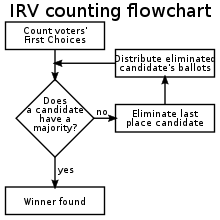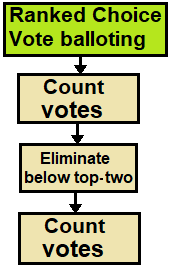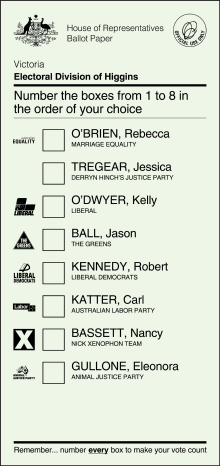Instant-runoff voting
[4][5][6][7] Since then, IRV has been criticized for other mathematical pathologies (discussed below), including its ability to eliminate candidates for having too much support or too many votes.[8] Like plurality, IRV also exhibits a kind of spoiler effect called a center squeeze,[9][10] which causes it to favor uncompromising alternatives over more-moderate ones,[11][12][13][14] which may in turn hinder a recovery from increasing polarization between the candidates and limit free entry.[15] Advocates of IRV often argue these properties are positive, as voting rules should encourage candidates to appeal to their core support or political base rather than a broad coalition.[16] They also note that in countries like the UK without primaries or runoffs, IRV can prevent spoiler effects by eliminating minor-party candidates.Unlike a straight plurality vote, IRV also avoids some kinds of vote-splitting by near-identical (clone) candidates.Some political scientists have found the system contributes to higher rates of spoiled votes,[20] partly because the ballot marking is more complex.In these scenarios, it would have been better for the third party voters if their candidate had not run at all (spoiler effect), or if they had voted dishonestly, ranking their favourite second rather than first (favorite betrayal).[35][20][36] Research has found IRV causes lower confidence in elections[37][38][39] and does not substantially affect minority representation,[40] voter turnout,[33][36] or long-run electoral competition.Federal judge Lance Walker rejected these claims, and the 1st circuit court denied Poliquin's emergency appeal.In a 2021 report, researchers at New America, a think tank based in Washington, D. C., said it may increase turnout by attracting more and more diverse candidates, but the impact would be realized most significantly by getting rid of the need for primaries.The Constitution of Ireland describes the electoral system as "proportional representation by means of the single transferable vote"[46], as do all other statutory authorities, when referring to either single-winner or multiple-winner elections.Jurisdictions in the United States such as San Francisco, Minneapolis, Maine, and Alaska have tended to use the term "ranked-choice voting" in their laws that apply to IRV contests.The San Francisco Department of Elections claimed the word "instant" in the term "instant-runoff voting" could confuse voters into expecting results to be immediately available.This method was first discussed by the Marquis de Condorcet in 1788, who quickly rejected it after showing it would often eliminate a candidate preferred by a majority of voters.[60][61] IRV was later independently reinvented by Thomas Hare (of England) and Carl Andrae (of Denmark) in the form of the single transferable vote.[64][65][66][67] In the United States, the sequential elimination method used by IRV is described in Robert's Rules of Order Newly Revised as an example of ranked-choice voting that can be used to elect officers.Because holding many rounds of voting on separate days is generally expensive, the exhaustive ballot is not used for large-scale, public elections.Under a variant of contingent voting used in Sri Lanka, and formerly for the elections for Mayor of London in the United Kingdom, voters rank a specified maximum number of candidates.IRV may also be part of a larger runoff process: In the Australian federal election in September 2013, 135 out of the 150 House of Representatives seats (or 90 percent) were won by the candidate who led on first preferences.[73][better source needed] A number of IRV methods, varying as to ballot design and as to whether or not voters are obliged to provide a full list of preferences, are in use in different countries and local governments.Other methods only allow marking preferences for a maximum of the voter's top three favourites, a form of partial preferential voting.[citation needed] As shown by Arrow, Gibbard, and others, it's usually impossible for a method to pass all of a number of seemingly reasonable properties, or criteria, at once.The independence of clones criterion states that "the election outcome remains the same even if an identical candidate who is equally preferred decides to run".Advocates have noted that IRV meeting this criterion[79][80] greatly reduces the impact of clones compared to FPTP.The independence of irrelevant alternatives criterion states that "the election outcome remains the same even if a candidate who cannot win decides to run."For comparison, note that traditional first-past-the-post voting would elect Memphis, even though most citizens consider it the worst choice, because 42% is larger than any other single city.The three major candidates were Brian Lenihan of Fianna Fáil, Austin Currie of Fine Gael, and Mary Robinson of the Labour Party.Another real-life example of IRV producing results different from first-past-the-post can be seen in the 2014 Victorian general election in Prahran.[86] In the 7th and final round, Hibbins narrowly defeated Liberal candidate Clem Newton-Brown by a margin of 277 votes.






Single transferable voteRanked votingSocial choiceelectoral systemsMechanism designComparative politicsComparisonBy countrySingle-winner methodspluralityFirst preference plurality (FPP)Two-roundJungle primaryPartisan primaryCondorcet methodsCondorcet-IRVRound-robin votingMinimaxSchulzeRanked pairsMaximal lotteryPositional votingBorda countBaldwinAntipluralityCoombsCardinal votingScore votingApproval votingMajority judgmentSTAR votingProportional representationParty-listApportionmentHighest averagesLargest remaindersNational remnantBiproportionalList typeClosed listOpen listPanachageList-free PRLocalized listQuota-remainder methodsHare STVSchulze STVCPO-STVQuota BordaApproval-based committeesThiele's methodPhragmen's methodExpanding approvals ruleMethod of equal sharesFractional social choiceDirect representationInteractive representationLiquid democracyFractional approval votingRandom ballotSemi-proportional representationCumulativeLimited votingMixed systemsMixed-member majoritarianMixed-member proportionalcompensatoryParallel (superposition)CoexistenceFusion (majority bonus)Vote linkage systemNegative vote transferMixed ballotSupermixed systemsDual-member proportionalRural–urban proportionalMajority jackpotSingle voteDouble simultaneous voteDual-voteSpoiler effectCloning paradoxFrustrated majorities paradoxCenter squeezePerverse responseBest-is-worst paradoxNo-show paradoxMultiple districts paradoxStrategic votingLesser evil votingTruncationTurkey-raisingmajority ruleTyranny of the majorityDiscursive dilemmaConflicting majorities paradoxSocial and collective choiceImpossibility theoremsArrow's theoremMajority impossibilityMoulin's impossibility theoremMcKelvey–Schofield chaos theoremGibbard's theoremMedian voter theoremCondorcet's jury theoremMay's theoremVCG mechanismQuadratic votingsingle-winnermulti-round elimination rulerunoff electionsfirst-preferencesplurality-with-elimination familytwo-round runoff systemin national elections in several countriesAnglosphereAustralian House of RepresentativesNational Parliament of Papua New Guineahead of stateIrelandSri LankaMarquis de Condorcetmajority-preferred candidateCondorcet winnertoo much supporttoo many votes